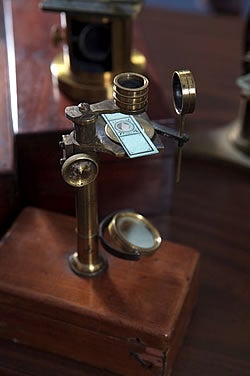Microscope exhibit under the eye beginning April 4 at Laupus Library
An East Carolina University professor’s quest to collect historically significant microscopes has turned into an exhibit at Laupus Library.
From April 4 through December 31, about 40 of Dr. Donald Hoffman’s microscopes will be showcased on all floors of the health sciences library. Hoffman is a longtime professor of pathology and laboratory medicine in the Brody School of Medicine.

This 1840 solid brass Gould- or Ellis-type microscope has its own wooden storage case and is said to be similar to one used by a young Charles Darwin in his five-year voyage on the Beagle.
The collection from Great Britain, France, Germany and United States dates from 1840 until 1960 and highlights an evolution of workmanship, style and function.
“It’s the single largest exhibit that we’ve developed in house for the library, and it’s all thanks to the generosity of Dr. Hoffman,” said Dr. Ruth Moskop, curator of history collections.
Hoffman is an expert in the history of microscopy and began collecting the microscopes only about a year ago. He has them all in working order too.
“It’s almost like stamp and coin collecting,” Hoffman said. “Collector’s value is mostly based on rarity and age.”
The oldest piece, a solid brass Gould- or Ellis-type microscope, dates to 1840, has its own wooden storage case and is said to be similar to one used by a young Charles Darwin in his five-year voyage on the Beagle.
“Almost all the older ones were solid brass, but a few of the later ones were steel,” he said. “They made all these fancy elaborate things before 1830 but they didn’t work very well. I have tried to get microscopes that people would have used or would use for laboratory education.”
The effects of daily rigor can be seen in knuckle rubbings on some of the instruments. Some are identical to models used by famous scientists, such as the founder of surgical pathology, Rudolf Virchow, and Paul Ehrlich, the founder of immunology.
“Others are important because they are the first of that type model,” Hoffman said. The first model stereomicroscope was used by Alexander Fleming, who discovered penicillin.
“Louis Pasteur used some of the cheapest microscopes he could get,” Hoffman said. “A lot of people thought simpler was better.”
There have been many changes in design. “The main changes in terms of lenses happened around 1880,” he said. “In the late 1880s, Zeiss made lenses had reached the resolution limit for visible light.”
Another of the microscopes in the exhibit is a U.S. Army hospital microscope used during the Civil War. Its maker, Joseph Zentmayer of Philadelphia, was one of the first to make a microscope in the United States. It is solid brass and weighs several pounds.
Two microscopes Hoffman would like to acquire are a Smith & Beck similar to one Darwin used and a pre-World War II era Zeiss model L.
“The biggest market is on eBay,” Hoffman said. He has also purchased through auction houses. Prices range from less than $100 up to $1,700. “You just have to keep trying for some things. We have bought a number from England and France. It’s a worldwide market.”
For a slide show of the microscope exhibit, go to http://www.pathology.ecu.edu/Public/microscopes.pdf. Laupus Library hours can be found at http://www.ecu.edu/cs-dhs/laupuslibrary/hours.cfm.
(Hoffman will lecture on the exhibit at 4:30 p.m. April 28 in the Evelyn Fike Laupus Gallery on the fourth floor of Laupus Library as part of the Medical History Interest Group series sponsored by the library’s History Collections and the ECU Department of Medical Humanities.